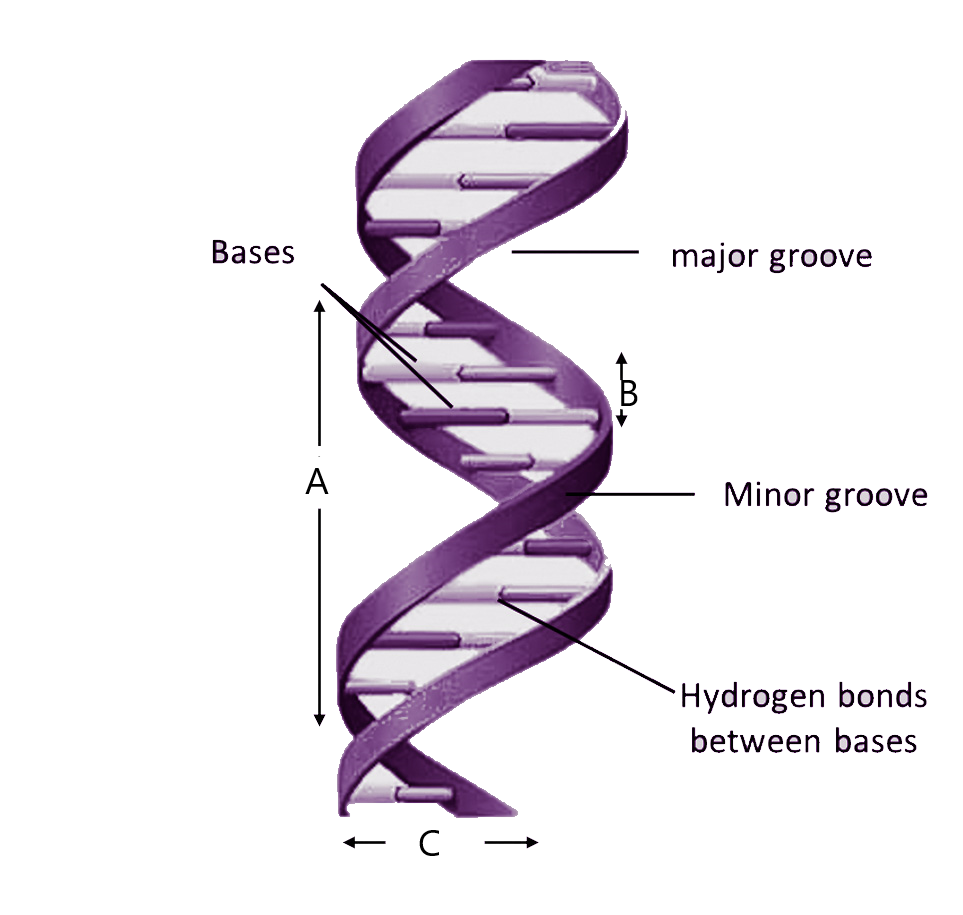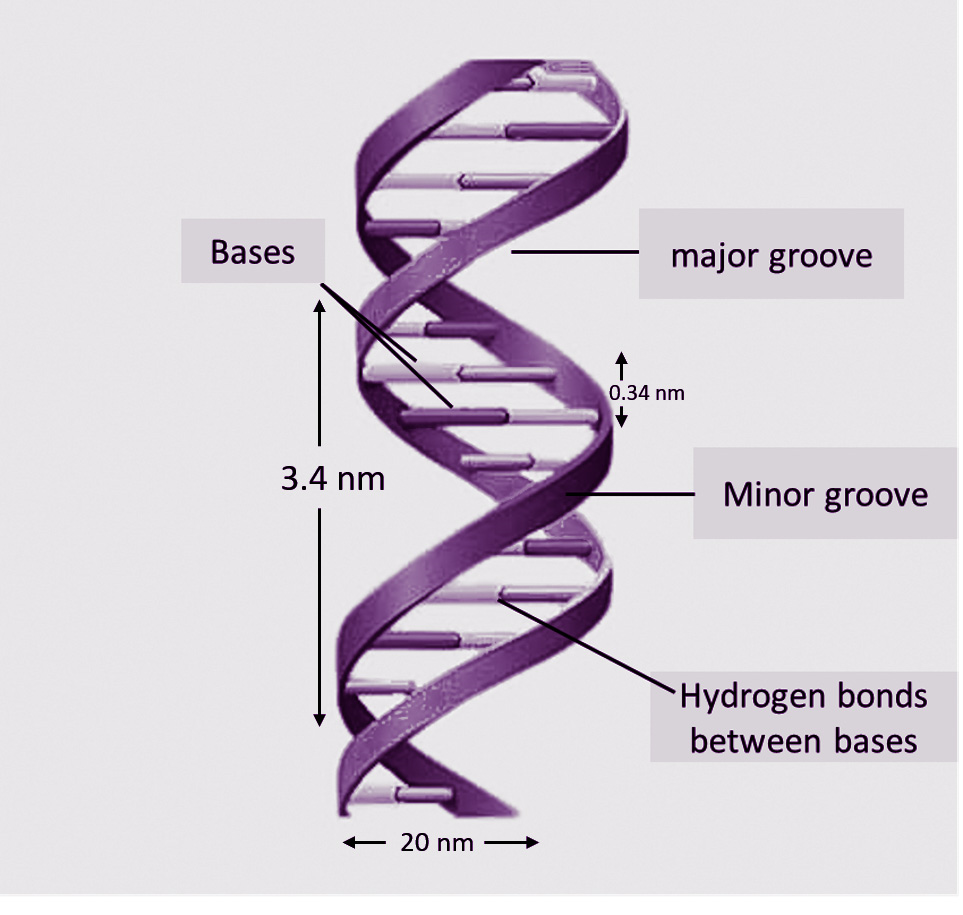
Given the figure represents the DNA double helix model proposed by Watson and Crick (1953). Select the option that shows the correct measurements of A, B, and C.

A. A-3.4 nm, B-0.34 nm, C-2 nm
B. A-34 nm, B-3.4 nm, C-20 nm
C. A-3.4 Å, B-0.34 Å, C-20 Å
D. A-34 Å, B-3.4 Å, C-2 Å

Answer
557.4k+ views
Hint: There are 10 nucleotides or base pairs per turn of the DNA double helix model and this model of DNA is known as the B DNA.
Complete answer:
The B DNA model proposed by Watson and Crick is a right-handed double helix structure. 10 nucleotides or base pairs are present in each turn and the distance between each base pair is 3.4 Å. The diameter of the DNA is 20 Å.
Pitch of the DNA double helix or each turn of DNA double helix has a length of 34Å or 3.4nm
Therefore the values of A, B, and C in the given figure are as follows:
-A is the pitch of the helix and the value is 34Å or 3.4nm
-B is the distance between two adjacent base pairs and the value is 3.4Å or 0.34nm
-C is the diameter of DNA double helix and its value is 20Å or 2nm
Additional Information:
Several other types of DNA models also exist besides the B DNA. The following chart consists of the types of DNA and their configurations:
The Structure of DNA has the following properties:
-Nucleotides are composed of sugar, phosphate, and a nitrogenous base. Many nucleotides join together by a phosphodiester bond to form a polynucleotide structure.
-Three types of bonds are present in DNA. N-glycosidic bonds are present between the nitrogenous base and pentose sugar. The phosphodiester bond is formed between 5’ carbon of one sugar of one nucleotide and 3’ carbon of another sugar of the next nucleotide. Hydrogen bonds are present between nitrogenous bases in a base pair. Three hydrogen bonds are present between guanine and cytosine. Two hydrogen bonds are present between adenine and thymine.
-The polynucleotide chain has a sugar and phosphate backbone and bases are present at right angles to it.
Chargaff's Rules: Some observations made on DNA structure.
-Adenine + guanine = thymine + cytosine
-The ratio of A+T/G+C is constant for a particular species.
So, the correct answer is, A-3.4 nm, B-0.34 nm, C-2 nm.
Note: Watson and Crick proposed only the B-DNA model of DNA double helix. Other models of DNA like A, C, and Z were not given by Watson and Crick. It is to be remembered all of the DNA types are right-handed helices only Z type DNA forms left-handed helix.

Complete answer:
The B DNA model proposed by Watson and Crick is a right-handed double helix structure. 10 nucleotides or base pairs are present in each turn and the distance between each base pair is 3.4 Å. The diameter of the DNA is 20 Å.
Pitch of the DNA double helix or each turn of DNA double helix has a length of 34Å or 3.4nm
Therefore the values of A, B, and C in the given figure are as follows:
-A is the pitch of the helix and the value is 34Å or 3.4nm
-B is the distance between two adjacent base pairs and the value is 3.4Å or 0.34nm
-C is the diameter of DNA double helix and its value is 20Å or 2nm
Additional Information:
Several other types of DNA models also exist besides the B DNA. The following chart consists of the types of DNA and their configurations:
| Type of DNA | Base Pairs per Turn | Rotation | Distance Between Base pairs | The diameter of the DNA helix |
| A | 11 | Right Handed | 2.5Å | 23Å |
| C | 9.33 | Right Handed | 3.3Å | 19Å |
| Z | 12 | Left Handed | 3.8Å | 18Å |
The Structure of DNA has the following properties:
-Nucleotides are composed of sugar, phosphate, and a nitrogenous base. Many nucleotides join together by a phosphodiester bond to form a polynucleotide structure.
-Three types of bonds are present in DNA. N-glycosidic bonds are present between the nitrogenous base and pentose sugar. The phosphodiester bond is formed between 5’ carbon of one sugar of one nucleotide and 3’ carbon of another sugar of the next nucleotide. Hydrogen bonds are present between nitrogenous bases in a base pair. Three hydrogen bonds are present between guanine and cytosine. Two hydrogen bonds are present between adenine and thymine.
-The polynucleotide chain has a sugar and phosphate backbone and bases are present at right angles to it.
Chargaff's Rules: Some observations made on DNA structure.
-Adenine + guanine = thymine + cytosine
-The ratio of A+T/G+C is constant for a particular species.
So, the correct answer is, A-3.4 nm, B-0.34 nm, C-2 nm.
Note: Watson and Crick proposed only the B-DNA model of DNA double helix. Other models of DNA like A, C, and Z were not given by Watson and Crick. It is to be remembered all of the DNA types are right-handed helices only Z type DNA forms left-handed helix.

Recently Updated Pages
Why are manures considered better than fertilizers class 11 biology CBSE

Find the coordinates of the midpoint of the line segment class 11 maths CBSE

Distinguish between static friction limiting friction class 11 physics CBSE

The Chairman of the constituent Assembly was A Jawaharlal class 11 social science CBSE

The first National Commission on Labour NCL submitted class 11 social science CBSE

Number of all subshell of n + l 7 is A 4 B 5 C 6 D class 11 chemistry CBSE

Trending doubts
10 examples of friction in our daily life

One Metric ton is equal to kg A 10000 B 1000 C 100 class 11 physics CBSE

Difference Between Prokaryotic Cells and Eukaryotic Cells

1 Quintal is equal to a 110 kg b 10 kg c 100kg d 1000 class 11 physics CBSE

State the laws of reflection of light

Explain zero factorial class 11 maths CBSE




